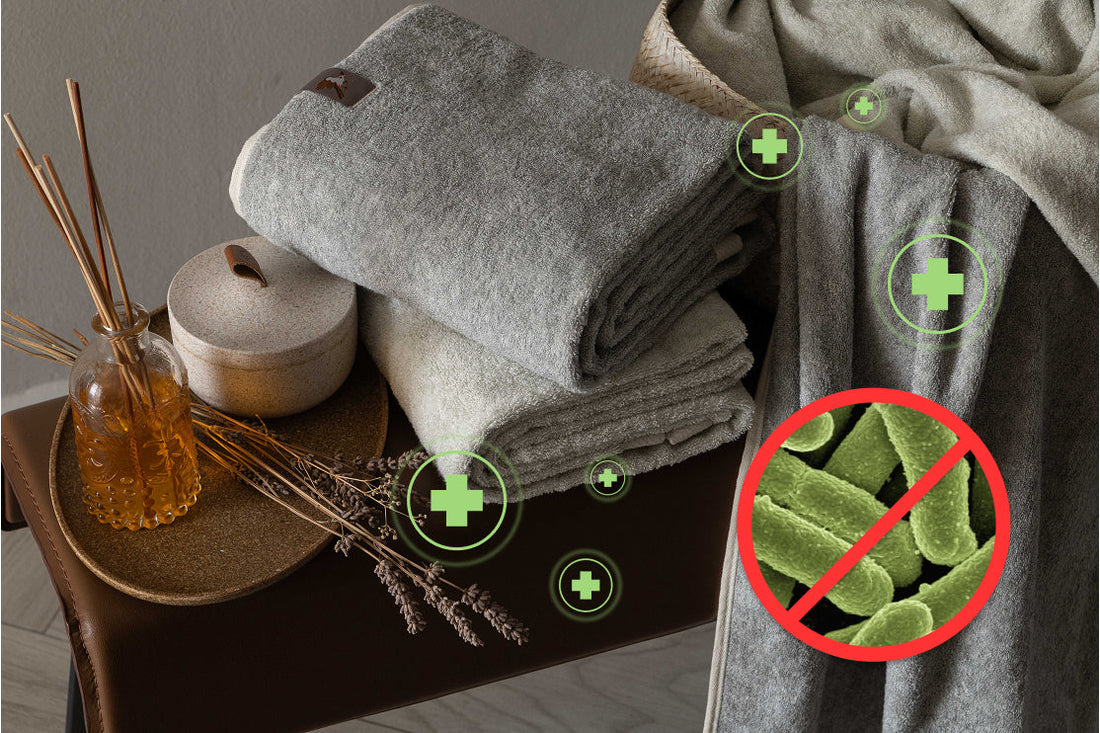
Understanding Antibacterial Towels: A Guide to Making the Right Choice
1. The Growing Need for Antibacterial Towels
In recent years, antibacterial towels have gained significant popularity among health-conscious consumers, and the science behind this trend is compelling. Traditional towels, while serving their primary function of drying, can become breeding grounds for harmful bacteria when moisture lingers in their fibers.
Research reveals the extent of bacterial contamination in everyday towels. Studies show that nearly 90% of bathroom towels were contaminated with coliform bacteria and about 14% carried E. coli. Kitchen towels fare no better, with about 73 per cent of towel samples testing positive for bacteria found in human intestines, including E. coli and Enterococcus species, while about 14 per cent grew Staphylococcus aureus.
The problem gets worse when towels are drying. Unlike other fabrics, towels have a thick, absorbent structure that traps moisture for longer periods. This damp environment is perfect for bacteria to multiply and form sticky layers called biofilms. This bacterial growth creates health risks, causes bad smells, and makes towels wear out faster.
Antibacterial towels address these concerns by incorporating antimicrobial properties directly into the textile, offering users a more hygienic and longer-lasting solution for daily use.
2. Methods of Applying Antibacterial Functionality
Understanding how antibacterial properties are incorporated into towels is crucial for making informed purchasing decisions. There are two primary approaches: surface coating and ionic bonding, each with distinct characteristics and performance profiles.
Surface Coating Method
Surface coating involves applying antimicrobial agents to the finished textile through post-processing treatments. This method typically uses chemical solutions containing silver nanoparticles, quaternary ammonium compounds, or other antimicrobial agents that are applied to the towel's surface.
Brief Summary: The coating process occurs after the towel is woven and finished. Antimicrobial agents are applied through dipping, spraying, or padding processes, creating a protective layer on the fiber surface.
Performance: Surface-coated towels show immediate antibacterial effectiveness upon application. The coating creates a barrier that inhibits bacterial growth on contact. However, this method faces challenges with durability.
Ionic Bonding Method
Ionic bonding integrates antimicrobial properties at the molecular level by incorporating metal ions (such as copper or silver) directly into the fiber structure during manufacturing. This process creates permanent bonds between the antimicrobial agent and the textile fibers.
Brief Summary: The antimicrobial material is integrated during the fiber production stage, creating molecular-level bonds that become part of the textile's inherent structure rather than a surface treatment.
Performance: Ionic bonding provides consistent antimicrobial performance throughout the towel's structure, not just on the surface. This method offers more uniform distribution of antimicrobial properties across the entire textile.
Long-term Functionality Comparison
When evaluating long-term effectiveness, ionic bonding demonstrates superior durability. Surface coatings gradually diminish with repeated washing and use, as the applied agents are physically removed from the textile surface. The coating method typically maintains effectiveness for 20-50 wash cycles, depending on the specific treatment and care conditions.
In contrast, ionic bonding maintains antimicrobial properties for the towel's entire lifespan. Experts recommend replacing bath towels every two to three years, with a maximum lifespan of five years, depending on usage and care. Since the antimicrobial agents are molecularly integrated into the fiber structure, they cannot be easily removed through normal washing and use. This means ionic bonding can provide antibacterial protection for 2-5 years, while surface coatings typically last only 20-50 wash cycles (approximately 6-12 months with regular use). This makes ionic bonding the superior method for sustained antibacterial functionality.
3. Common Sources for Antibacterial Properties
Bamboo: The Natural Antibacterial Myth
Bamboo has been marketed as a naturally antibacterial material due to a substance called "bamboo kun" found in raw bamboo plants. This natural antibacterial effect makes bamboo fabric an attractive option for clothing, bedding, and even towels.
However, scientific research reveals a different reality. There is no credible scientific evidence to suggest that bamboo's natural antibacterial agent survives the intensive chemical processing required to make rayon. The manufacturing process to convert bamboo into textile fibres involves harsh chemical treatments that destroy the natural antimicrobial compounds.
Studies confirm this finding: No evidence was found that regenerated bamboo fibre fabrics are superior to other regenerated cellulose fibres such as viscose rayon, nor that the antimicrobial properties of natural bamboo remain unchanged in regenerated bamboo fibres. Research also shows that natural bamboo fibre has no natural antibacterial properties, as compared with other natural fibres.
If bamboo towels demonstrate any antibacterial properties, these likely result from additional chemical treatments applied during or after manufacturing, not from the bamboo itself.
Copper: The Multifunctional Mineral
Copper offers genuine antibacterial properties that extend beyond basic antimicrobial function. This mineral provides various benefits including reducing electromagnetic waves, anti-dust properties, and antistatic effects. Copper's antimicrobial mechanism works through the release of copper ions that disrupt bacterial cell walls and interfere with cellular processes.
Importantly, copper is recognized as a mineral that is harmless to both people and the environment when used in textile applications. Its effectiveness against bacteria, viruses, and fungi has been scientifically validated, making it a reliable choice for antibacterial textiles.
Silver: Powerful but Costly
Silver possesses strong antibacterial power and has been used for centuries for its antimicrobial properties. Silver ions effectively neutralize bacteria by disrupting their cellular functions and preventing reproduction.
However, silver comes with significant limitations. Its high cost makes silver-treated towels expensive for consumers. Additionally, silver typically provides basic functions such as antibacterial and deodorizing properties without the additional benefits such as anti-dust, Antistatic etc which copper offers.
Most importantly, towels made with silver commonly use post-processing coating methods. This means the silver is applied to the towel's surface after manufacturing, leading to decreased functionality over time as the coating wears away through washing and use.
4. How to Choose the Right Antibacterial Towel
Understanding Common Manufacturing Methods
Most towels follow a standard production process: fibres are spun into yarn, woven into fabric, and then finished with various treatments. For functional towels, antibacterial properties are typically added through post-processing treatments such as silver coating or chemical antibacterial applications.
However, some manufacturers take a different approach. Products like Bulbul's Copper towel apply functionality at the yarn level, integrating copper ions directly into the fibre structure. This method reduces reliance on post-processing treatments and utilises the pure antibacterial properties of copper without additional chemical modifications.
Key Factors to Consider
1. Application Method: When choosing an antibacterial towel, investigate whether the manufacturer uses coating or ionic bonding methods. Ionic bonding provides superior longevity, ensuring the towel maintains its antibacterial properties throughout its entire lifespan rather than just for the first few uses.
2. Antimicrobial Source: Examine what creates the towel's antibacterial properties. Avoid products that rely on surface coatings like silver treatments, which diminish over time. Be wary of claims about natural bamboo antibacterial properties, as these typically fade during the fabrication process. Instead, look for towels that use the inherent properties of materials like copper, which maintain their effectiveness indefinitely.
3. Manufacturing Integration: Consider how the antimicrobial properties are integrated into the product. Towels that incorporate functionality at the yarn or fibre level, rather than through post-processing, offer more durable and consistent performance.

Conclusion
Choosing the right antibacterial towel requires understanding the science behind different manufacturing methods and antimicrobial sources. While surface coatings may provide immediate antibacterial effects, ionic bonding methods offer superior long-term performance. Materials like copper provide genuine, lasting antimicrobial properties along with additional functional benefits, while claims about natural bamboo antibacterial properties should be viewed with healthy skepticism.
By focusing on products that integrate antimicrobial functionality at the fibre level and use proven materials like copper, consumers can invest in towels that provide lasting protection against bacterial growth, better value for money, and contribute to a more hygienic daily routine. The key is to look beyond marketing claims and understand the underlying technology that makes these products effective.




